This is an AI Free Zone! Text created by ChatGPT and other Large Language Models is spreading rapidly across the Internet. It's well-written, artificial, frequently inaccurate. If you find a mistake on Spaceweather.com, rest assured it was made by a real human being. | | |
EARTH-DIRECTED EXPLOSION (UPDATED): A magnetic filament on the sun erupted during the late hours of Aug. 30th, opening a "canyon of fire" in the sun's northern hemisphere. New coronagraph images from SOHO show a faint halo CME en route to Earth (movie). A NASA model of the CME predicts it will hit our planet on Sept. 2nd, possibly sparking G1-class geomagnetic storms. Aurora alerts: SMS Text
THE BLUE SUPERMOON: Spoiler alert: It wasn't blue. Last night's perigean supermoon wowed observers around the world with 15% more luminosity than an ordinary full Moon. The family of Ali Rahimi witnessed the super moonrise from Isfahan, Iran:
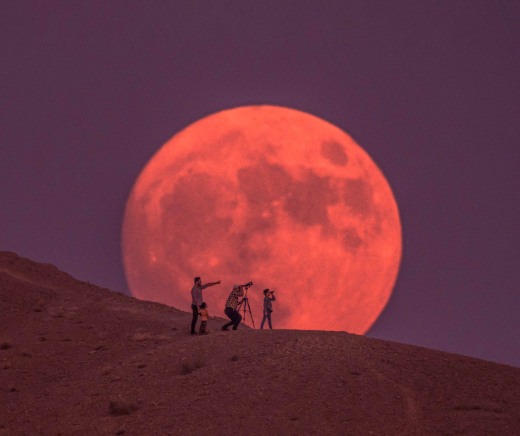
"This shot took some planning," says Rahimi. "My father, my uncle and my cousin's son joined me on a hillside to observe the Moon, while my camera snapped the picture from 900 meters away."
As in many other photos we've received, the full Moon was reddened by scattering in Earth's atmosphere. Folklore deemed it "blue," however, because it was the second full Moon in a calendar month. The only time a full Moon actually turns blue is just after a volcanic eruption or when viewed through certain forest fires. Red is better.
more images: from Michel Benvenuto of Nice, France; from Paolo Bardelli of Sumirago (Varese), Italy; from Chris Cook of Seal Beach, California; from Dewey Vanderhoff of Cody, Wyoming
Realtime Space Weather Photo Gallery
Free: Spaceweather.com Newsletter
WHO NEEDS A SOLAR FLARE? The sun did not flare on Aug. 23rd, and there was no geomagnetic storm. Nevertheless, rural skies in Europe filled with a green aurora-like glow. Sylvain Chapeland sends this picture from the south of France:
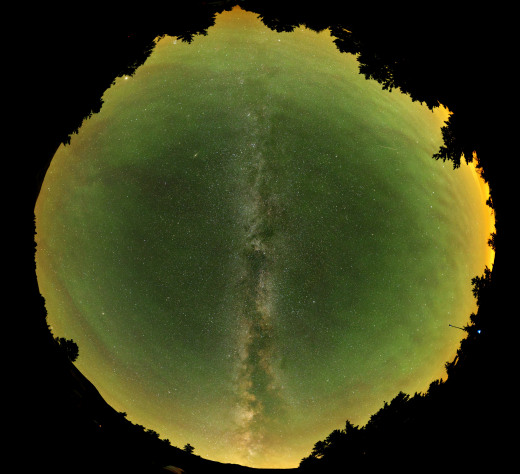
"I spent a week stargazing in the mountains and enjoyed excellent observing conditions," says Chapeland. "On the last night I noticed significant airglow. I never saw before such bright green airglow in all directions."
It might look like aurora, but it is not. Green airglow is produced by photochemistry in Earth's upper atmosphere. Approximately 95 km above Earth's surface, there is a layer of air where oxygen atoms (O) and oxygen molecules (O2) co-exist. When O bumps into O2, the collision creates a spark of green light--airglow.
Solar Max is boosting this process. Higher-than-normal UV radiation from the active sun is heating Earth's upper atmosphere, increasing the rate of O vs. O2 collisions. The resulting airglow may be observed on very dark nights from anywhere on Earth. It is often invisible to the naked eye, but an easy target for digital cameras with nighttime exposures. Got a picture? Submit it here.
Realtime Airglow Photo Gallery
Free: Spaceweather.com Newsletter
18K GOLD CUPID'S COMPASS: Are you looking for a romantic gift? Consider Cupid's Compass. This premuim 18K gold-filled pendant flew to the stratosphere on Jan. 6th onboard an Earth to Sky Calculus cosmic ray research balloon:
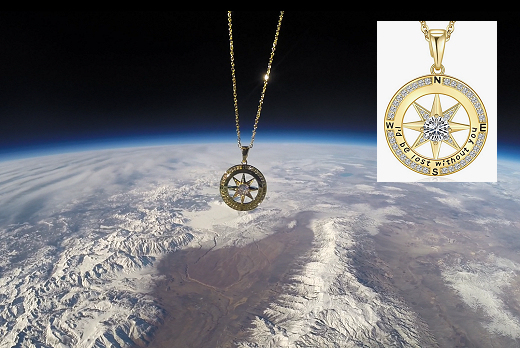
You can have it for $259.95. Engraved with the words "I'd be lost without you", the hypoallergenic pendant has a 5-star cubic zirconia crystal in the middle surrounded by a ring of equally high-grade 5A cubic zirconia nuggets. It is a visually striking pendant that makes a once-in-a-lifetime Valentine's, anniversary or birthday gift.
The students are selling space pendants to pay the helium bill for their cosmic ray ballooning program. Each one comes with a greeting card showing the jewelry in flight and telling the story of its trip to the stratosphere and back again.
Far Out Gifts: Earth to Sky Store
All sales support hands-on STEM education
Realtime Aurora Photo Gallery
Free: Spaceweather.com Newsletter
Every night, a network of
NASA all-sky cameras scans the skies above the United States for meteoritic fireballs. Automated software maintained by NASA's Meteoroid Environment Office calculates their orbits, velocity, penetration depth in Earth's atmosphere and many other characteristics. Daily results are presented here on Spaceweather.com.
On Aug 31, 2023, the network reported 19 fireballs.
(19 sporadics)
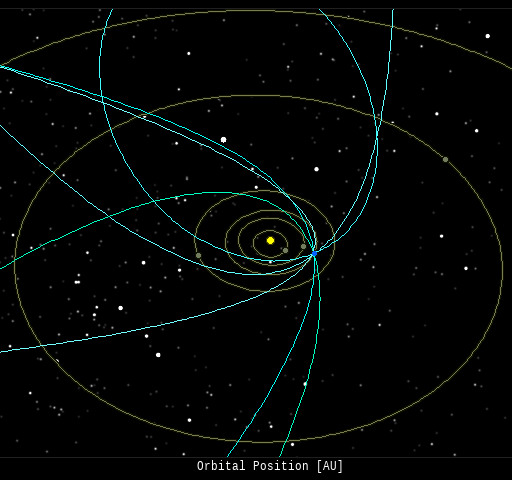
In this diagram of the inner solar system, all of the fireball orbits intersect at a single point--Earth. The orbits are color-coded by velocity, from slow (red) to fast (blue). [Larger image] [movies]
Potentially Hazardous Asteroids (
PHAs) are space rocks larger than approximately 100m that can come closer to Earth than 0.05 AU. None of the known PHAs is on a collision course with our planet, although astronomers are finding
new ones all the time.
On August 31, 2023 there were 2349 potentially hazardous asteroids.
 |
Recent & Upcoming Earth-asteroid encounters: | Asteroid | Date(UT) | Miss Distance | Velocity (km/s) | Diameter (m) |
| 2023 QT1 | 2023-Aug-26 | 11.5 LD | 10.6 | 33 |
| 2023 QO7 | 2023-Aug-26 | 7.7 LD | 11.6 | 49 |
| 2007 RR17 | 2023-Aug-26 | 8.3 LD | 7.1 | 63 |
| 2023 QR1 | 2023-Aug-27 | 4.3 LD | 5 | 13 |
| 2023 QQ | 2023-Aug-27 | 10.7 LD | 10.1 | 25 |
| 2023 QJ5 | 2023-Aug-27 | 4.6 LD | 12.2 | 14 |
| 2023 QZ6 | 2023-Aug-27 | 9.1 LD | 17.7 | 38 |
| 2023 QK5 | 2023-Aug-29 | 3.9 LD | 6.8 | 11 |
| 2023 QD2 | 2023-Aug-29 | 3.3 LD | 7.8 | 15 |
| 2012 PZ17 | 2023-Aug-30 | 16.8 LD | 3.6 | 16 |
| 2023 QH | 2023-Aug-31 | 12 LD | 15.9 | 64 |
| 2023 QB2 | 2023-Sep-01 | 8.1 LD | 7.2 | 19 |
| 2023 QZ1 | 2023-Sep-01 | 18.2 LD | 18.6 | 52 |
| 2023 QU | 2023-Sep-02 | 13.6 LD | 9.8 | 34 |
| 2017 BY32 | 2023-Sep-02 | 16.4 LD | 3.5 | 19 |
| 2023 QG | 2023-Sep-03 | 11.6 LD | 13.7 | 75 |
| 2023 QH1 | 2023-Sep-03 | 13.1 LD | 6.4 | 23 |
| 2021 JA5 | 2023-Sep-06 | 13.3 LD | 10.9 | 19 |
| 2023 QC5 | 2023-Sep-08 | 10.6 LD | 7.6 | 27 |
| 2020 GE | 2023-Sep-08 | 14.9 LD | 1.4 | 8 |
| 2023 QF6 | 2023-Sep-10 | 7 LD | 10.5 | 22 |
| 2020 RT2 | 2023-Sep-12 | 11 LD | 10 | 8 |
| 2016 LY48 | 2023-Sep-16 | 5 LD | 10.8 | 99 |
| 2010 TE | 2023-Sep-16 | 6.8 LD | 6 | 22 |
| 523598 | 2023-Sep-20 | 19.8 LD | 25 | 239 |
| 2019 SF6 | 2023-Sep-26 | 16.7 LD | 8.6 | 20 |
| 2013 TG6 | 2023-Sep-28 | 3.6 LD | 4.1 | 17 |
| 2009 UG | 2023-Sep-30 | 6.1 LD | 9 | 78 |
| 349507 | 2023-Oct-03 | 16.5 LD | 21 | 696 |
| 2022 FX1 | 2023-Oct-04 | 20 LD | 9.9 | 25 |
| 2022 TD | 2023-Oct-07 | 8.9 LD | 9.4 | 10 |
| 2018 ER1 | 2023-Oct-08 | 12.5 LD | 5.3 | 27 |
| 2022 UX1 | 2023-Oct-11 | 3.1 LD | 8.6 | 9 |
| 2015 KW120 | 2023-Oct-12 | 18.2 LD | 13 | 22 |
| 2021 NT14 | 2023-Oct-13 | 18.6 LD | 8.6 | 254 |
| 2011 GA | 2023-Oct-15 | 6.8 LD | 16.6 | 230 |
| 2007 SQ6 | 2023-Oct-15 | 19.4 LD | 6.5 | 130 |
| 2019 UZ3 | 2023-Oct-16 | 9.6 LD | 8.3 | 14 |
| 1998 HH49 | 2023-Oct-17 | 3.1 LD | 14.8 | 193 |
| 2022 UO10 | 2023-Oct-19 | 7.8 LD | 9.8 | 16 |
| 2020 UR | 2023-Oct-20 | 5.8 LD | 12.9 | 9 |
| 2020 FM6 | 2023-Oct-23 | 15.5 LD | 15.9 | 149 |
| 2019 HH4 | 2023-Oct-24 | 13.3 LD | 20 | 365 |
| 2021 SZ4 | 2023-Oct-26 | 14 LD | 30 | 287 |
| 302169 | 2023-Oct-26 | 12.7 LD | 25.7 | 374 |
Notes: LD means "Lunar Distance." 1 LD = 384,401 km, the distance between Earth and the Moon. 1 LD also equals 0.00256 AU. | | Cosmic Rays in the Atmosphere |
SPACE WEATHER BALLOON DATA: Almost once a week, Spaceweather.com and the students of Earth to Sky Calculus fly space weather balloons to the stratosphere over California. These balloons are equipped with sensors that detect secondary cosmic rays, a form of radiation from space that can penetrate all the way down to Earth's surface. Our monitoring program has been underway without interruption for 7 years, resulting in a unique dataset of in situ atmospheric measurements.
Latest results (July 2022): Atmospheric radiation is decreasing in 2022. Our latest measurements in July 2022 registered a 6-year low:
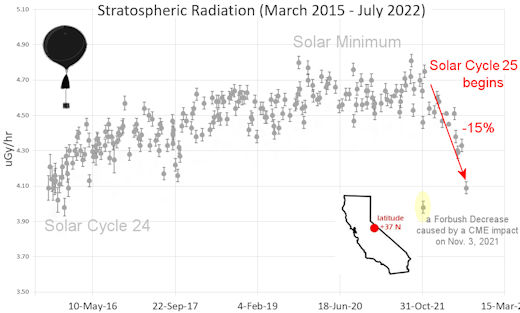
What's going on? Ironically, the radiation drop is caused by increasing solar activity. Solar Cycle 25 has roared to life faster than forecasters expected. The sun's strengthening and increasingly tangled magnetic field repels cosmic rays from deep space. In addition, solar coronal mass ejections (CMEs) sweep aside cosmic rays, causing sharp reductions called "Forbush Decreases." The two effects blend together to bring daily radiation levels down.
.Who cares? Cosmic rays are a surprisingly "down to Earth" form of space weather. They can alter the chemistry of the atmosphere, trigger lightning, and penetrate commercial airplanes. According to a study from the Harvard T.H. Chan school of public health, crews of aircraft have higher rates of cancer than the general population. The researchers listed cosmic rays, irregular sleep habits, and chemical contaminants as leading risk factors. A number of controversial studies (#1, #2, #3, #4) go even further, linking cosmic rays with cardiac arrhythmias and sudden cardiac death.
Technical notes: The radiation sensors onboard our helium balloons detect X-rays and gamma-rays in the energy range 10 keV to 20 MeV. These energies span the range of medical X-ray machines and airport security scanners.
Data points in the graph labeled "Stratospheric Radiation" correspond to the peak of the Regener-Pfotzer maximum, which lies about 67,000 feet above central California. When cosmic rays crash into Earth's atmosphere, they produce a spray of secondary particles that is most intense at the entrance to the stratosphere. Physicists Eric Regener and Georg Pfotzer discovered the maximum using balloons in the 1930s and it is what we are measuring today.
| | The official U.S. government space weather bureau |
| | The first place to look for information about sundogs, pillars, rainbows and related phenomena. |
| | Researchers call it a "Hubble for the sun." SDO is the most advanced solar observatory ever. |
| | 3D views of the sun from NASA's Solar and Terrestrial Relations Observatory |
| | Realtime and archival images of the Sun from SOHO. |
| | information about sunspots based on the latest NOAA/USAF Active Region Summary |
| | current counts of failed and deployed Starlink satellites from Jonathan's Space Page |
| | Authoritative predictions of space junk and satellite re-entries |
| | from the NOAA Space Environment Center |
| | fun to read, but should be taken with a grain of salt! Forecasts looking ahead more than a few days are often wrong. |
| | from the NOAA Space Environment Center |
| | the underlying science of space weather |
 | When looking for casinos to play online when the weather is bad, you can try casino online trucchi for Italian games. If you are not from Finland you can try the Swedish page Svenska casino online to find suitable games, check out svenskacasinoonline.net. Always check your local laws before playing with real money. |
 | BestCSGOGambling is the best site for everything related to CSGO gambling on the web |
| | These links help Spaceweather.com stay online. Thank you to our supporters! |
| | | | | | |

